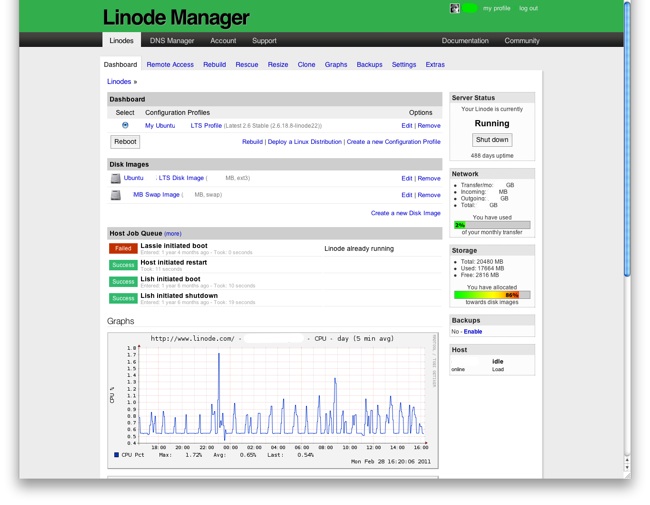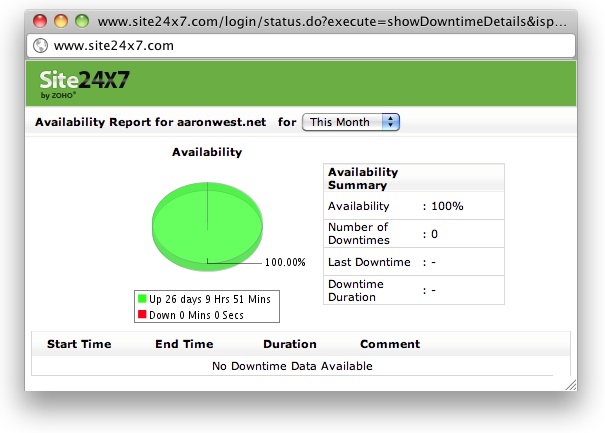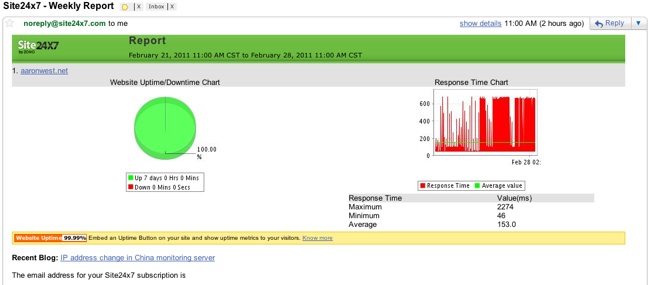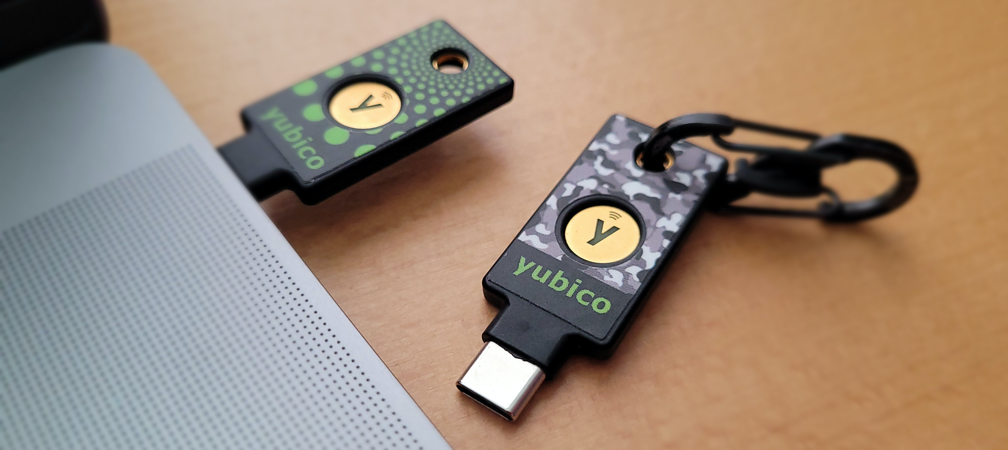For the past few months I’ve been planning on writing a post about the services that make this site possible. I’ve read these sorts of posts on other sites and they seem very marketing heavy. They’re often titled “sponsor post” or something equivalent. This post is different. I’m genuinely a fan (and customer) of all of these services and in most cases I pay for them monthly. After the break I discuss each service/app I rely on to power this site. I put each service within category blocks such as: the server, the app, backups, uptime, etc.
The Server
I tried shared hosting for a number of years and it simply didn’t work for me. I moved my sites to a Linux VPS and loved it. But eventually, I found my way back home to Linode. Which is interesting because I’ve been a customer of Linode before it was Linode. I created my first vanity domain in 2000 and hosted it with a co-workers company, Shore Network Technologies. That same gent, Chris Aker, went on to launch Linode in 2003 and I’ve been using their virtual Linux solutions since.

When it comes to Linux hosting I only recommend Linode. They have intuitive tools, competitive pricing, and the absolute best customer service you will experience in the hosting biz. You get to choose the type of performance and growth you need and you can deploy just about any Linux distribution available. If you outgrow your virtual server it’s ridiculously easy to migrate to a new, more capable host. You have several choices when it comes to managing your Linode servers. You can use their excellent Web-based Linode Manager (screenshot above) or several mobile tools such as the official iPhone app or the unofficial Android app. For more reasons to use Linode, check out this list.
With all the Linux talk it’s obvious what operating system I use. I have a bit of experience on both CentOS and Ubuntu but I generally choose Ubuntu 64-bit for all my servers. I also try and use the LTS (long-term support) versions wherever possible. These versions of Ubuntu are typically released every two years and they come with three years of support versus 18 months. I’ve been running this site on Ubuntu for several years.
The App
At the application level this site is powered by Adobe ColdFusion and Ray Camden’s BlogCFC blogging software. I’ve been using ColdFusion since starting my first real programming job in 2000. At that time most of the work I did with CF was parsing text files in a bunch of different formats. Over the years I’ve used CF for the most basic of Web sites to powering over 2,000 Web sites on a large cluster. Most of my recent work with ColdFusion includes several cloud deployments using ColdFusion 9 Enterprise and using CF as the back-end for Adobe Flex 4 applications.
In short, I’m a huge fan of ColdFusion. It makes my programming life easier. I’ve tried several other programming languages and I always use CF when I need to do heavy lifting or when I need to deploy an enterprise-class application or site. Sitting on top of ColdFusion and powering my entire site is the excellent BlogCFC. I’ve been using it since 2005 and have put it up against other blogging software such as MangoBlog and Wordpress. I continue to use BlogCFC for a few reasons. First, it’s written in ColdFusion and it’s open source. So I can make just about any changes I want to it. Second, it’s simple. I use MangoBlog for another site and it too is great blogging software but digging into the guts of it takes a lot more time and dedication than does BlogCFC. Finally, Ray is constantly making improvements to BlogCFC by adding features and fixing bugs. I wish I was just as diligent about upgrading my own copy.
Disaster Recovery
This Web site is extremely important to me. Yes it’s a personal blog and no I don’t really make much money from it, but I’ve been blogging since 2002 and accumulating content that I want to protect. Having a disaster recovery plan is essential. My old plan was a completely manual process. I’d back up site files via FTP and launch a SQL tool to run backups of the database server. It sucked. Horribly. Then I learned about Tomahawk Backup, a company which like Linode was started by a friend and co-worker. Tomahawk is geared towards small businesses who don’t have the technical capacity to manage their offsite backups or who don’t want to spend the money to hire an IT person. I needed a service that was mostly “set it and forget” and that I could rely on to backup my databases on a daily basis. I also wanted a system that could keep my backups for at least 90 days in the event I had a database issue and the last few days of my backups weren’t valid.
I have Tomahawk installed as a service on my Linux servers which runs in the background. It’s configured to backup my databases on a daily basis and store the backup files off of my server and the datacenter my servers run in. My data, although not technically private, is encrypted and cannot be read by anyone other than myself, including the Tomahawk staff. Restoring one of my backups is pretty easy using the tools on the Tomahawk Web site. I simply log-in, access my backup history and select which backup from the last 90 days I want to restore. In order to get the files downloaded to my laptop a private encryption key must be provided. But once I have the files I can use them to restore a database on my laptop, thereby refreshing my development environment. Or, in the event of a production crash, I can transfer the files to the original server and get my database back up and running. It’s a lifesaver really, and knowing things will go wrong at some point I can sleep at night knowing my data is safely stored off-site. Other things I like about Tomahawk include: you determine your backup schedule and what gets backed up, you choose your encryption key, you choose your data retention policy, and you’re in control of the restore process. You don’t have to call Tomahawk when something goes wrong, though if you do you’ll get some amazing help within just a few rings. In short, it just works.
Ask yourself this: If my site or app goes offline right now will that cause problems? If my data vanishes today will I be able to get it back? If you aren’t comfortable with your answers to these questions I encourage you to look into Tomahawk and get the piece of mind you need.
Monitoring Uptime
Finally, I want to talk a bit about monitoring. I haven’t always monitored this site and I’ve been lucky. I’ve rarely had problems. But when I do I’m never the first person to find out. And it is always embarrassing. How I’ve found out about down time in the past typically involved someone nice enough to e-mail me or send me a tweet to let me know my site was down. This bothered me on a few levels but mostly because I simply wanted my site to be online all the time. While investigating different monitoring providers I kept coming across Site 24x7. I read about them and a few other services on Mashable too. After signing up for trial accounts on a few of the services I decided to go with Site24x7.
Site24x7 has a nice pricing structure though it’s very different from what you might be used to. You pay based on how many sites you want to monitor, how often you want them monitored, and from how many different locations. If you need to monitor a site every 60 seconds things can get a little expensive, but for my needs 60 seconds is overkill. Rarely will I be able to respond to a downage within 60 seconds of being notified. Second, they have the best Web site of all the monitoring services I tried. It’s simple, it’s super fast, and the reporting is robust yet entirely approachable.


Next, they support several different notification types including SMS and e-mail. I’m away from a computer often so receiving notifications on my mobile device is critical. Most of the notifications I’ve received to date have occurred when I’m sleeping so without SMS I wouldn’t even know things went wrong. Finally, you can monitor your sites from just about anywhere in the world. When you create a new monitor you decide from where you want the monitoring to occur. The more locations you pick the more expensive the service gets so it’s a good idea to spread the monitoring out. I try to pick one or two locations in the US - such as the east coast and west coast - and then one or two overseas. This level of customization with each monitor is something you won’t find anywhere else. Did I mention they have a nice mobile-optimized Web site? It looks great and works awesome on iPhone and Android.
I sleep well at night
Combining a pretty good disaster recovery plan with off-site backups, and site monitoring with Site24x7 I sleep well at night. Each of these services I’ve written about are really great otherwise I wouldn’t use them or be recommending them to you. If you’re in need of Linux virtual server hosting please check out the fine folks at Linode. If you need a complete application stack to handle your every need I highly recommend Adobe ColdFusion. If you need ColdFusion-based, open source blogging software you must check out BlogCFC. And if you need to create or enhance your disaster recovery plan and site monitoring abilities, check out Tomahawk Backup and Site 24x7. All of these products make this Web site possible and I thank them for their support and for doing great work.
